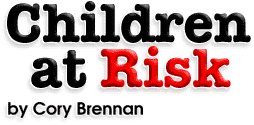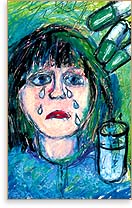
|


 A recent county task force report amplifies existing concerns over abuses and deaths of children in the child protection system. Overdrugging with powerful and dangerous psychiatric drugs is high among the dangers facing these children.
A recent county task force report amplifies existing concerns over abuses and deaths of children in the child protection system. Overdrugging with powerful and dangerous psychiatric drugs is high among the dangers facing these children.

os Angeles County’s child protective system came under renewed scrutiny and criticism in early 2000 in a report issued by the Los Angeles County Board of Supervisors-appointed Foster Care Task Force. Formed after an alarming increase in deaths of children in foster care between May and August 1999, the Task Force charges that safeguards are lacking and that children in foster care have no greater protection than other children in the community.
...........................
The problem of child overdrugging is rampant. Critics of child protective services argue that in many cases, children are more at risk in child protective systems than outside of them.
...........................
|
|
Increased deaths were the latest of acute concerns about the system. An in-depth investigation conducted by The Los Angeles Times in May 1998 found that thousands of children in state foster or group homes were being administered powerful psychiatric drugs, mostly for the purpose of making the kids easier to manage. In Los Angeles County alone, dependency court judges approved requests to medicate 4,500 children in one year.
More recent revelations of the fate of one 2 1/2-year-old foster child, Oei Mae, epitomizes the lack of safety precautions exercised in the drugging of foster children. The toddler, a ward of the Los Angeles Juvenile Court placed in a state-licensed foster home, was hospitalized more than a year ago in Santa Barbara after slipping into a coma and experiencing seizures, severe brain injury and liver failure, according to a report in the Los Angeles Daily Journal.
Mae’s condition was induced by a combination of seven powerful drugs—including mind-altering psychotropics Prozac, Xanax and Depakote, sedative drugs Clonidine and phenobarbital, and two antihistamines. Now four years old, Mae has been described as “profoundly retarded” as a result of the drugging.
The drugs were administered by her foster mother. The doctor who prescribed most of them attributed Mae’s outcome to “horrible luck,” according to the Journal report.
Rampant Problem
Although some may call Oie Mae’s case an extreme one, the problem of child overdrugging is rampant, not just in California.
On a national level, critics of child protective services argue that in many cases, children are more at risk in child protective systems than outside of them.
“When taken from the home, the child suffers a trauma and begins misbehaving in the foster home,” said Suzanne Shell, author and founder of the national Family Advocacy Center located in Utah. “Social services does not recognize this and says it is from the trauma suffered in the [original] home. So when the child gets out of control [in the foster home], they put him on drugs,” worsening the situation.
Children under the influence of psychiatric drugs have suffered drug-induced psychosis, hallucinations, abnormal heart activity, uncontrollable tremors, liver problems, and other “complications,” including death.
Judges in Los Angeles County were so concerned about the wholesale drugging of children in the system that they implemented a program which requires each psychiatric diagnosis and prescription to be reviewed by the county psychiatrist and then approved by the court. It does not, however, appear to have made much difference. A Los Angeles grand jury reported that an audit of 158 cases found that in nearly half the cases, children were drugged without the required legal consent.
The Task Force report and the Oei Mae case indicate that the problem may be even more widespread now than before.
Mae was reportedly drugged without the required court consent, according to the Journal report. But even more fundamental is how and why a toddler would be considered a candidate for powerful psychiatric drugs to begin with.
Other Incentives?
These and many other facts in the Mae case are still unanswered, and still obscured. But information on national trends collected by child advocacy groups indicate that one reason for the administration of the psychiatric drugs may have stemmed from Mae’s designation as a “special needs” child; she was exposed prenatally to street drugs and was developmentally delayed, even though the prospects of leading a normal life were quite good.
Children designated as having special needs are usually placed on a psychiatric treatment plan, often long-term.
On a national scale, concerns have been raised by child protective system reformers that financial incentives may at times overshadow care: For each child designated as having special needs, states receive more federal funding. Further, foster parents for children designated as having special needs can receive as much as $1,000 per month per child and take as many as four such children.
The qualifications of foster parents have also been raised as a subject for tighter scrutiny and review. The foster parent responsible for Mae was reported to have said that she was taking as many as a dozen drugs herself including multiple mind-altering psychiatric drugs, and also was arrested twice for shoplifting, as revealed by the Journal.
Lasting Reforms Urged
Information on the full and current extent of abuse in custody care is murky due to a lack of reporting rigor. The Federal Child Abuse and Prevention Act of 1974 was amended in 1996 to include, among other things, a provision requiring annual reports by states on certain categories of incidents that children experience in custody, including abuses and deaths.
...........................
The problem of child overdrugging is rampant. Critics of child protective services argue that in many cases, children are more at risk in child protective systems than outside of them.
...........................
|
|
“The improvement was only on paper,” says James Roger Brown, sociologist with The Sociology Center in Little Rock, Arkansas, which has extensively investigated abuses of the child protective services in different states. “What I have found in trying to collect the reports that are supposed to be produced, is that no one has actually produced any of them.”
Shell adds, “When a child is abused in a foster home or in an institution while in state custody, the state investigates itself. That is something we cannot tolerate.”
Child welfare advocates are presenting evidence to state and federal representatives and urging that a congressional investigation be called toward the end of revamping the laws governing child protective agencies and child welfare.
High on the list of recommended changes is to eliminate state immunity for those in child protective services who are charged with the well-being of the children in the system. State employees involved in removing a child from the home and in caring for a child once he has entered state custody cannot be prosecuted. Making them as accountable as others would be a key step in righting the wrongs, according to Shell and Brown.
“Each individual worker has to be held accountable for what they do to the children and the family—for their action or for the lack of action they take that is harmful,” Shell said.
Other groups, including the Citizens Commission on Human Rights (CCHR), a psychiatric watchdog group established in 1969 by the Church of Scientology, and professor of psychiatry emeritus and author Thomas Szasz, also look to a fundamental shift in outlook when it comes to care of children.
“What a child placed in foster care needs is happy and stable adults, as much love and attention as they can get, and plenty of constructive activities,” said Rick Palmquist, Executive Director, CCHR Los Angeles. “Children who come from broken families are no doubt upset or troubled. Diagnosing them with ‘mental illness’ and giving them a chemical babysitter because of their circumstances is not just fallacy, but very harmful.”
The problem starts once the children arrive in the system, and usually well before they are placed with foster parents.
Many times, “kids just want to be seen or heard,” said Nettie Clark, president of the Metro-Crenshaw Foster Parents Association and a foster mother since 1986. “These children want to be loved and feel someone cares about them.” Clark said that at times she would have a child for three or four days and then social services would show up at the door with medication, saying that the child was to be taking it when the child “was doing just fine without it.”
Until reforms are widely adopted, more harm and deaths will occur at the hands of those who have lost sight of the primary mission of the protection of children.
|

|




 A recent county task force report amplifies existing concerns over abuses and deaths of children in the child protection system. Overdrugging with powerful and dangerous psychiatric drugs is high among the dangers facing these children.
A recent county task force report amplifies existing concerns over abuses and deaths of children in the child protection system. Overdrugging with powerful and dangerous psychiatric drugs is high among the dangers facing these children.
